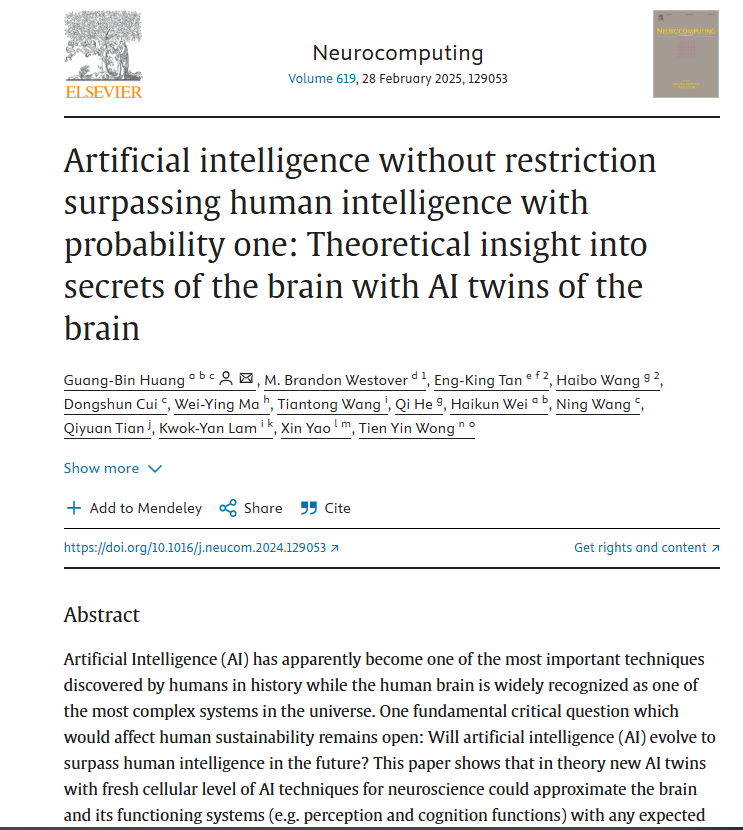A recent eye-catching study points out that artificial intelligence (AI) is expected to surpass human intelligence in the future. The research team proposed a novel theoretical framework that uses AI technology to infinitely approach or even surpass the functions of the human brain by simulating the human brain at the cellular level. With its innovative perspective and potential breakthrough significance, this research has attracted widespread attention from academia and industry. The core of this research is to apply AI technology to neuroscience and build an "AI twin" of the human brain, thereby improving the micro-level Understand and simulate the complex workings of the human brain.
Artificial intelligence (AI) has the potential to surpass human intelligence in the future, a new study suggests. This research deeply explores the complexity of AI and the human brain, and proposes a new theoretical framework, that is, by applying AI technology to the cellular level of neuroscience, AI can infinitely approach the functions of the human brain, and even eventually surpass humans. Intelligence level.
The human brain is widely regarded as one of the most complex systems in the universe, and artificial intelligence is regarded as one of the most important technologies in human history. A core question lies before us: Will artificial intelligence eventually surpass human intelligence? This study believes that the answer is yes.

The study proposes that by using new AI technologies, we can create "AI twins" of the human brain. These AI components can simulate the basic units of the human brain such as neurons and synapses, thereby approximating the operation of the human brain at the cellular level, including perception and cognitive functions. Through this method, in theory, AI can infinitely approach the functions of the human brain and eventually surpass human intelligence.
The core of the research is that it does not use traditional neuroscience research methods, but replaces the basic components of the human brain, such as neurons and synapses, with corresponding AI components. Researchers believe that various areas and functional subsystems of the human brain (such as vision, smell, hearing and reasoning systems) can be approximated by corresponding AI twins, and the errors can be controlled within a very small range.
Key findings of the study:
AI has unlimited potential: AI can theoretically surpass the intelligence level of the human brain.
Cell-level simulation: AI technology can accurately simulate basic units such as neurons and synapses of the human brain.
Human brain function approximation: Various areas and functional subsystems of the human brain can be infinitely approximated using AI twins.
Opening up a new field of AI: Without restrictions, AI will develop into a new discipline with its own systems and principles.
Promote interdisciplinary collaboration: Call for interdisciplinary teams across the globe to work together to model different types of neurons and synapses in the human brain.
Safe and controllable AI: Committed to developing controllable, explainable and safe AI technology with reasoning capabilities and the ability to discover natural laws.
Research challenges:
Limitations of traditional modeling methods: Classic mathematical modeling and neurodynamic methods are difficult to fully understand the complexity and learning mechanism of the human brain.
The complexity of the human brain: The human brain is composed of billions of neurons and trillions of synapses, with a complex structure and diverse functions.
Microscopic level research: In-depth study of the mathematical representation and molecular behavior of neurons and synapses is required.
Future outlook:
AI-assisted neuroscience: AI technologies such as AI twins will be used for dynamic analysis of neuroscience at the cellular level and solutions to brain diseases.
New AI technology: Develop low-power AI technology using the basic properties of neuroscience.
Exploring the laws of nature: New AI technology will have reasoning capabilities and be able to discover the laws of nature.
This research shows that the potential of artificial intelligence goes far beyond existing applications. By simulating the cell-level structure of the human brain, AI is expected to surpass human intelligence in the future and bring new breakthroughs to neuroscience research. This research also indicates that AI may develop into a new discipline with its own systems and principles, like mathematics and physics.
Paper address: https://www.sciencedirect.com/science/article/abs/pii/S0925231224018241
All in all, this research points out a new direction for the future development of artificial intelligence and provides a new way to understand the mysteries of the human brain. However, challenges still exist, and it requires the joint efforts of global scientific research forces to ultimately achieve this goal and ensure the safe and controllable development of AI technology.